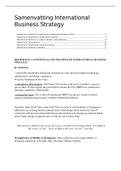Samenvatting International
Business Strategy
HOOFDSTUK I. CONCEPTUAL FOUNDATIONS OF INTERNATIONAL BUSINESS STRATEGY............................................................1
HOOFDSTUK II. ARCHETYPES OF ADMINISTRATIVE HERITAGE:............................................................................................3
HOOFDSTUK III. P&H’S CC’S VS. SBUS + PORTER’S MODEL/DIAMOND.............................................................................6
HOOFDSTUK IV. GLOBALIZATION...............................................................................................................................11
HOOFDSTUK V. INTERNATIONAL STRATEGIC ALLIANCES..................................................................................................17
HOOFDSTUK VI. EMERGING ECONOMIES.....................................................................................................................21
HOOFDSTUK I. CONCEPTUAL FOUNDATIONS OF INTERNATIONAL BUSINESS
STRATEGY
§1. NLB FSA
= technically transferable abroad and maintains its value after this transfer (technology,
administrative knowledge, reputation)
can be transferred in two ways:
- embedded in final products: firm keeps FSA at home, and uses it to produce a good or
service there then exports the good which contains the FSA (BMW-car: produced in
Germany, exported to Netherlands)
- intermediate input: FSA is directly transferred (BMW sets up new venture in Brazil:
superior manufacturing processes would be transferred to Brazil)
Necessary firms MUST have some NLB FSAs (in order to offset liability of foreignness =
additional cost of doing business abroad (lack of knowledge about local taste, lack of
connection with local government/businesses,discrimination by foreign government (think
about China; foreign companies have to link up with Chinese firm)
“eBay may be a Shark in the ocean, but I am a crocodile in the Yangtze River. If we fight in
the ocean, we lose – but if we fight in the river, we win”- Jack Ma
importance of liability of foreignness: eBay would face such a large liability of
foreigness (turned out to be right; eBay shut down Chinese website)
,§2. LB FSA:
cannot be transferred abroad, or are technically transferable abroad but lose too much
value when transferred (ex.; stores at favorable locations, knowledge of local customer
preferences)
Locally obtained FSAs must be bundled with NLB FSA
example of Honda; it transferred from China to US by transferring it NLB FSA
(manufacturing, supplier management) and obtained LB knowledge about US Car industry.
(BUNDLING APPROACH)
§3. Location advantages
favourable conditions in external environment from which firms are able to benefit. (firms
have FSAs, territories may have location advantages)
Scope of LA may vary;
subnational (economic clusters as Silicon Valley = knowledge clusters)
national (Ireland, NL, Luxembourg; favorable tax regimes BUT LA can still vary
(Apple agreement with Irish government; pay 0,005% tax),
supranational
Firms can enjoy LA at home and abroad to get access to LA, firms do FDI:
§4. Motivations for FDI
a. Natural resource seeking: oil, fertile land
b. Market seeking: search for new customers (most common)
c. Strategic resource seeking: desire to gain acces to new advanced resources
d. Efficiency seeking: lower cost (production, transportation, taxation)
An FDI can have multiple motivations (
example of Apple: FDI in Ireland motivated by (1) strategic resource seeking (English-
speaking, well-educated workers (2) efficiency (tax) (3) Market seeking (Irish market for
digital devices)
Firm should only do FDI when OLI-paradigm is fulfilled:
1) Ownership advantage: must have NLBs to offset the liability of foreignness
2) Location advantage: locating abroad must be more attractive than locating it at home
3) Internalization advantage: must be more attractive for the firm to perform the activity
itself
NLB FSA are not always enough: firms must also enjoy LB FSAs in combination with LA
, HOOFDSTUK II. ARCHETYPES OF ADMINISTRATIVE HERITAGE:
NLB FSAs LB FSAs LA
Centralized Keeps FSAs in home No attempt to Customer base
exporter country, and develop LB FSAs abroad
transfers NLB FSA
embedded in
products
International Transferring abroad No attempt to
projector as intermediate develop LB FSAs
inputs
International Transfers different No attempt to
coordinator FSAs to different develop LB FSAs
countries (dependent
of LA) +
overarching FSA in
logistics
Multi-centered Transfers very few Relies heavily on
MNE NLB FSAs; only key development of LB
routines (corp. FSAs: responsive to
values, fin. local market needs
Centralized exporter: only foreign activities are sales/marketing (think about Honda; in the
beginning centralized exporter, afterwards also production abroad)
Other firms remained a centralized exporter: Hollywood studios (keep on producing in US,
export movies)
International projectors: domestic business model will work as well as abroad they make
‘clone’ domestic units
Example of Disney: replicated US theme Park in countries as France, Hong Kong,…
Shanghai; new park that is based on Chinese tradition not only an international projector
International coordinator: transfer FSAs in marketing to countries with large customer base,
transfer upstream knowledge unit to countries with well-educated workers
main FSA of international coordinator: international logistics (coordination specialized
value chain activities performed in different countries) (oval in picture)
Example of vertically integrated oil companies: oil exploration in countries with oil, ship
to refineries to strategic locations (port of Rotterdam) and ship to strategic markets





